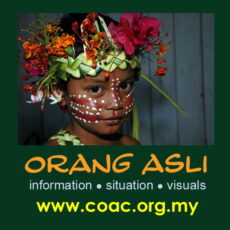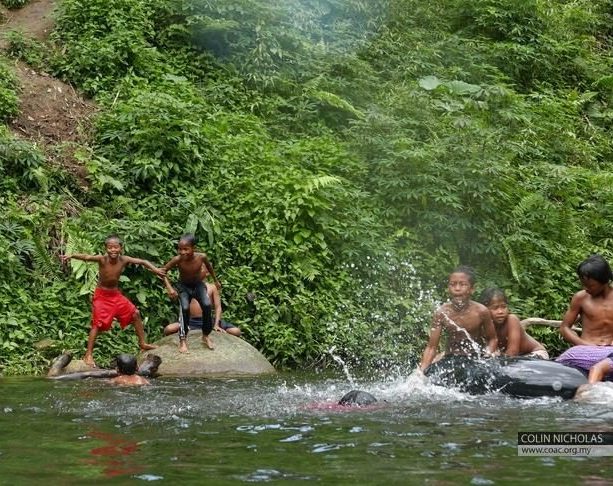Like previous years, 2015 had been an eventful one, both for the Orang Asli and for us at COAC.
There were many things that broke our hearts or stirred up anger and frustration in us – like the damage done by the floods in January, the treatment of Orang Asli schoolchildren in Kelantan, continued encroachments into their traditional lands, devastation of their environments, misrepresentation of their situation, or the continuing moves to pit Orang Asli against Orang Asli.
But there were also a few that raised our spirits and reaffirmed our hope that the path ahead is not always dark and downhill. Here are some of the things that boosted our morale in 2015.
Orang Asli Empowering Themselves
When the floods hit the northeastern states on 26 December 2014, the Orang Asli in Gua Musang did not sit and wait for aid and handouts.
They immediately organized themselves and set up a Flood Relief Committee based in Kampung Parik, RPS Kuala Betis. Donations in kind that went through this committee reached all the affected communities, with little duplication or wastage of resources.
They knew where the villages were that needed the help, knew who had been ‘reached and assisted’, and knew what kind of aid was needed.
Some of the Temiar flood relief committee members planning the aid delivery trips for the day.
Some of the food aid had to flown in to remote communities in Kelantan. This was done with the aid of the good people from United Sikhs for Humanity.
Rebuilding
With a generous (unsolicited) RM300,000.00 grant from Hong Leong Foundation meant for flood relief, COAC decided to use the money for rebuilding purposes rather than for flood relief efforts (which was the original intention). This was because there was already sufficient donations and contributions from the public for this purpose. Re-building lives and homes would be a more longer-term need.
Thus, when the flood problem eased in February, the building of 24 houses in the 4 hamlets of Kampung Angkek-Podek began. The community decided who needed the houses and where they were to be built. They also decided on the size and design of the houses, and placed orders for the building materials needed themselves.
The houses were built by themselves on a gotong-royong basis. No outside volunteers, no big-shots for photo-ops, and no publicity.
24 houses in the Podek-Angkek area of Kuala Betis that were damaged or destroyed by the floods were rebuilt by the community itself, with financial support from Hong Leong Foundation for the building materials and food for the gotong royong.
The design, size and structural materials to be used, were decided by the recipients themselves. Each house cost about RM11,000.00, the main costs being the good quality hardwood timber (which, ironically, in all probability were harvested from their forests!).
Disaster Preparedness
Seeing the effects of the floods, some communities decided to be better prepared for the next big one. One measure was to build or re-site their community halls (or balai adat, in some cases) on higher ground. Not only were these buildings to be used for their usual cultural and social activities, they also would be an available safe-place should floods recur.
Some communities also worked together in groups to start projects such as banana farms with the dual aim of it being an income-generation project as well as a food source during times of calamity-induced food shortages.
COAC helped source funding for these projects from the DAP, the Dr. Bolton Orang Asli Trust Fund as well as utilized the funds from the Hong Leong Foundation grant mentioned above.
The balai adat at Pos Ber built with a grant of RM300.00 (for food for the gotong royong). The building materials were sourced from the forest by the community themselves. The balai adat now serves as the new focus for cultural activities as well as a flood relocation centre if need be.
The DAP funded this banana farm for 6 families in Pos Ber. Meant to serve as an income generation-cum-food resource in times of need, the project also allows other food crops (like maize and vegetables) to be harvested before the bananas mature.
Orang Asli Education, the community way
The Semai community of Kampung Ulu Tual in Pos Sinderut is a sterling example of what a community can do for itself with regard to the education of their children. With only an idea in their minds, and a couple of dedicated Orang Asli teacher-organisers, they decided to forge ahead and build a 120-foot community learning center in their village.
The plan was to have preschool classes where their children not only learned what other kids learn in regular kindergartens, but also for them to also learn their culture, language and indigenous institutions.
With donations and contributions from several individuals and organisations, the learning center was launched in April and now serves not only the preschool kids but also the younger schoolchildren, the teenage dropouts and even the adults, who use the center regularly for their various activities.
The learning center was designed, constructed and is managed by the community themselves.
The children are receptive to learning mainly because they trust the teachers and the other adults entrusted with their care, who are also all Orang Asli themselves.
Success in Courts
The Orang Asli were successful in three indigenous land rights cases in 2015 where the courts ruled in their favour.
Kampung Bukit Rok-Kampung Ibam (Semelai) case at the Court of Appeal.
On 13 October, the Court of Appeal today upheld the Temerloh High Court’s ruling that the creation of the Bera Malay Reservation in 1923 did not extinguish the prior-existing native title rights of the Semelai in the Bukit Rok-Kampung Ibam customary lands of the Semelai people in the Bera area.
The Court of Appeal also held that the Semelai held native title rights to their customary lands, as long as those lands were settled, planted, occupied and controlled by the Semelai people.
The Kampung Peta case (Jakun) in the Johor Baru High Court.
On October 21, the High Court at Johor Baru found that the Jakun-Orang Asli of Kampung Peta were customary owners of the land which included parts of the Endau-Rompin National Park, which they had been residing in since the 1800s.
The judge ordered the State and Federal governments to survey the entire 6,000ha area of the Endau-Rompin National Park and adjacent Krau Forest Reserve within 18 months and to de-gazette areas previously gazetted as forest or wildlife reserves but fall within the customary lands of the Orang Asli of Kampung Peta.
The Kampung Senta (Semai) case in the Ipoh High Court.
On 30 September, the Ipoh High Court ruled that the Semai of Kampung Senta in Bidor, Perak enjoyed native title rights to their tanah adat (customary lands) under common law.
The judge accepted the plaintiff’s testimony, which was supported by the expert report, that they are the traditional owners of the land since early times. As such, he ordered the state government to revoke the land title given to a private company and take steps to gazette the Orang Asli’s customary lands.
In all the three cases, COAC was involved directly by way of expert reports (by Colin) being submitted to the court on the history, presence and situation of the community in question. In all cases, as stated in their judgment, the judges referred to the reports and based part of their decisions on them.
Three other cases – involving the Orang Seletar of Danga Bay (Johor), the Semaq Beri of Kampung Mengkapor (Pahang), and the Temiar of Pos Belatim (Kelantan) – are in various stages in the courts. Expert reports were prepared for all.
JOAS’s Temiar Women’s worskhop in Kampung Amgkek, RPS Kuala Betis, Kelantan
Orang Asli Women on the Rise
Contrary to what is popularly perceived Orang Asli women are still largely discriminated against and excluded in much of Orang Asli affairs and local politics.
Under the auspices of JOAS, the Indigenous Peoples Network of Malaysia, 2015 saw the involvement of more Orang Asli women in Orang Asli affairs. Workshops were also held to help create awareness of their rights and also to understand the local situation.
Two Orang Asli women groups were established, based in Kampung Angkek (Kelantan) and Kampung Jemeri (Pahang) that helped to sow some confidence, initiative and self-determination among them.
JOAS’s women’s workshop at Kampung Jemeri, Rompin, Pahang
Public Support
Also spirit-lifting in 2015 was the increase in support and empathy from Malaysians generally and our friends from overseas.
When the floods affected some Orang Asli communities, many people came forward to help in cash and kind. A total of RM208,000.00 was collected in public donations, apart from the donations of food and other materials. Individuals and corporate bodies were also more generous to the Orang Asli, funding local level projects or supporting various community efforts.
COAC is also grateful to our friends and supporters who continue to support us, financially or otherwise, in our work. As we do not receive–or apply for–any institutional funding, these contributions, however small, are always greatly appreciated. Thank you.
We wish 2016 to be a more fulfilling, progressive and safe year for everyone.
COAC | 1 January 2016

